|
Cheyenne
   
   
   
   
Cheyenne 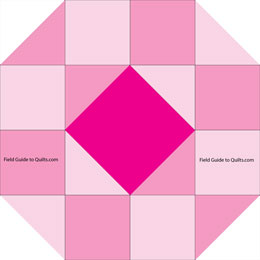 Cheyenne Cheyenne
KCS, 1933
The year 1933 is the earliest definitive date for this block's publication, in the Kansas City Star.
The Star illustrated the block as an octagon rather than a square. That was a tad misleading, because the blocks can only be linked with, in effect, a single on-point square that shares a side with each of 4 octagons.
Or you can alternate the corner colors, creating a variation of Cheyenne, at least by this site's definition. Others would count only the underlying pattern of pieces as an individual block, no matter what the colors.
|
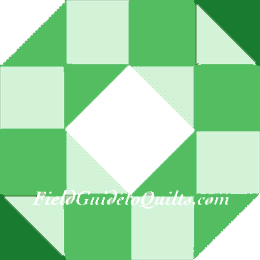   
   
   
   
Cheyenne variation |
|
Golden Gates
                Golden Gates Golden Gates
 Golden Gates
LAC, #117 Golden Gates
LAC, #117
1897
In any case, the block was numbered #117, and when it was finished using the LAC's pattern, it was 24 inches across. |
|
Ozark Cobble Stone
 Ozark Cobble Stone Ozark Cobble Stone
KCS, 1936The Ozark Cobble Stone is not a block per se but a way to lay out octagons on a quilt top by adding a square to four of an octagon's eight sides.
In the Kansas City Star, which published the block in 1936, every hexagon was made from a different scrap fabric and the squares were of a single solid color. |

Ozark Cobble Stone |
|
Rosalia Flower Garden
 Rosalia Flower Garden Rosalia Flower Garden
KCS, 1939  Jack's Chain Jack's Chain
Rosalia Flower Garden has an hexagonal center, but the block itself is a dodecagon. That's right—it has 12 sides. e blocks link together so that they share a 3x3 checkerboard on each side.
The block is from the Kansas City Star, 1939. The Star recommended a print for the squares, yellow for the triangles, and white for the rest. Click on the block to see a whole-quilt mockup.
Marcia Hohn explains how to make this imposing block in QuiltersCache.com. You'll go to her instruction page when you click the icon at upper right. Hats off to Allison Person for alerting us to the page! |
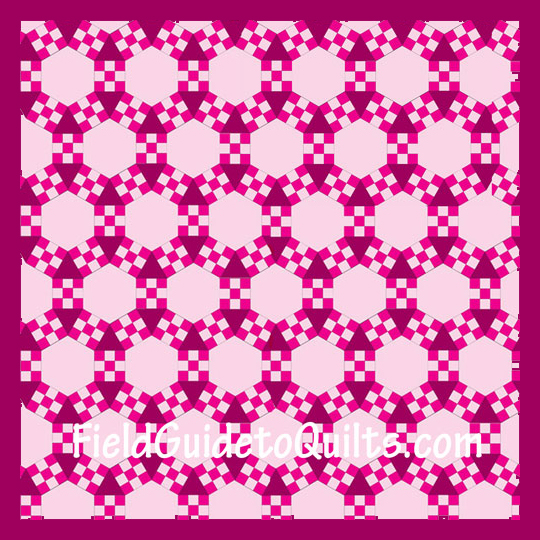
Rosalia Flower Garden |
|
Caesar's Crown
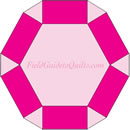
Caesar's CrownThis unusual block has a hexagonal center, but its outer edge is an irregular octagon, and looking at a single block gives you far less than the whole picture. In the whole-quilt mockup, each block has the feel of a spiky hexagon.
We cannot verify the block name. Our source is the eBay seller French72, who auctioned a quilt of this pattern in September 2016.
This unusual block has a hexagonal center, but its outer edge is an irregular octagon, and looking at a single block gives you far less than the whole picture. In the whole-quilt mockup, each block has the feel of a spiky hexagon.
We cannot verify the block name. Our source is the eBay seller French72, who auctioned a quilt of this pattern in September 2016.
Photos below courtesy of French72, eBay seller.
| 
Caesar's Crown
|
|
Twist Patchwork (Khin)
 Twist Patchwork (Khin) Twist Patchwork (Khin)
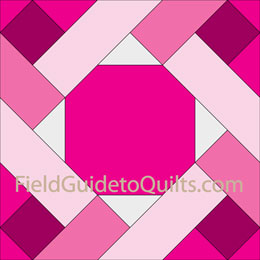 Twist Patchwork Twist Patchwork
Khin, 1988
This version of Twist Patchwork is from Yvonne Khin's Collectors Dictionary of Quilt Names and Patterns (1988). The four-color block makes a satisfying collection of patterns on a quilt top.
You do have to pay close attention to color values, especially if you're using prints.
Comparing light values means figuring out which fabric is lighter than the other, but it's more complicated than it sounds. Darker tints can be intense instead of dark, and lighter hues can look darker than they really are if they're camouflaged with an eye-fooling color. The real challenge is to compare prints.
Quilters use a gadget called a "Ruby Beholder," known to non-quilters as a piece of red Plexiglas, aka red light filter, to gauge light values.
Spread out your fabrics and behold them through the ruby doobie thing, and the colors magically turn into black, white, and gray.
We hear that blue filters help too, but we haven't tried them ourselves. |
|
Twist Patchwork (LAC)
 Twist Patchwork
Twist Patchwork
LAC #294
1897
From the Ladies Art Company's 1897 catalog comes a design that duplicates the cane seats in vintage chairs. Our block is an eight-patch (or a four-patch, depending on who's talking), while the LAC's was based on a 16 x 16 grid. It is the LAC's block #294.
The LAC illustration showed four of the blocks that we've pictured at left. |
|
 |
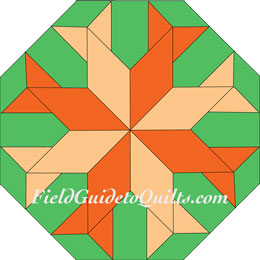 Octagons & others
Octagons & others Octagons & others
Octagons & others